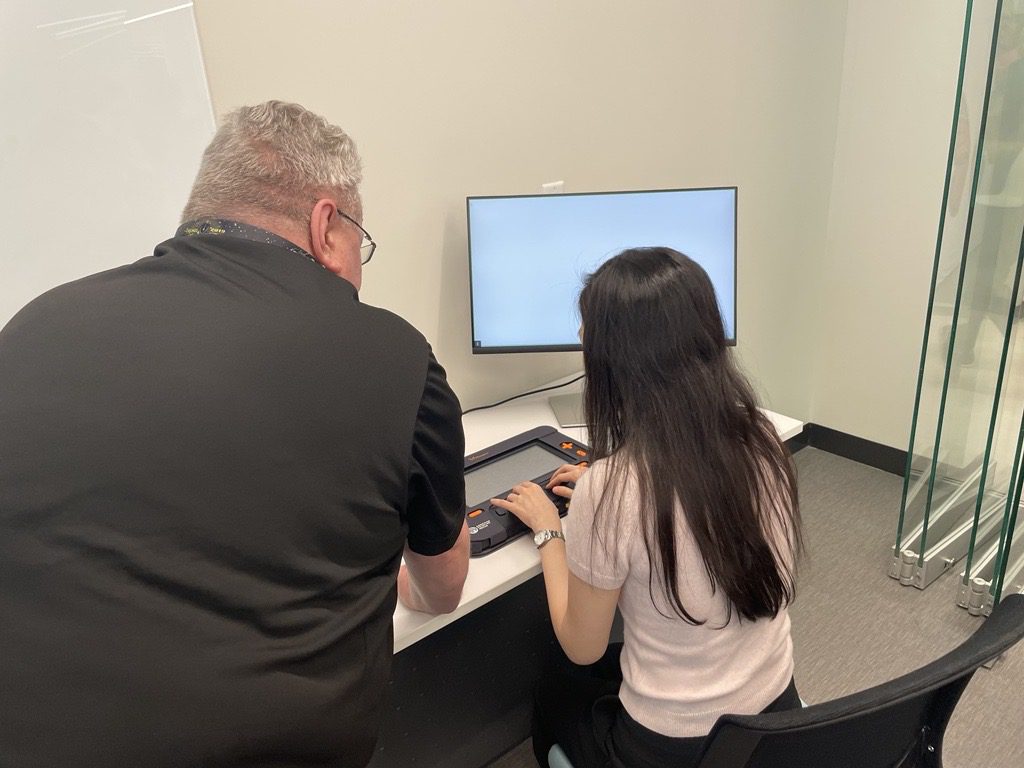Simplifying Standardized Tests with the Monarch

Standardized tests can be a source of anxiety for students who are blind or have low vision. Although they are required to be given in an accessible format, new adaptations need to be made to accommodate the switch from hard copy tests to computerized versions. The APH Monarch serves as a tool to make these testing experiences easier for all.
Lori Cole, Teacher Supervisor of the Braille and Adaptive Technology Department at the Arkansas School for the Blind and Visually Impaired, says her students used to receive braille testing booklets and input their answers on the computer. This year, students will be completing the ATLAS test, a computer-based exam accessible with a screen reader and refreshable braille display. The test also includes braille on demand, where students can ask the proctor to emboss a specific passage or question containing a tactile graphic. The student will then receive the hard copy braille, review it, and input their answer on the computer. The braille is necessary because most one-line refreshable braille displays can not show users tactile graphics.
Lori believes it will save time and paper if on-demand questions are shown on the 10-line by 32-cell display of the Monarch. Proctors could give students a flash drive with the requested material so they could plug it into the Monarch. Tactile graphics could be shown in the tactile viewer application; passages could be read in the word processor; and students could solve math problems on the calculator. Students also have the ability to change the braille spacing on the display for easier viewing. This solution would make the testing period shorter and easier for students. Once it supports more applications, students may be able to use the Secure Test app to take the test directly on the Monarch.
The state of Florida has recently switched to taking standardized tests on a computer. “We haven’t had the chance to get the computer platform set up to work with a braille display and screen reader. Right now, our students are getting hard copy braille versions of the computer test that their peers are taking,” Elizabeth Anderson, an EOT and supervisor at the Florida Instructional Resource Center for the Visually Impaired (FIMC-VI), said. Soon, the computer tests will adapt to each student, meaning the questions can change depending on how a student answers them. This also shifts the number of questions in each test. “By doing this, you’re getting a more accurate picture of the student’s achievement and performance, and then you’re getting immediate results,” Elizabeth explained. “With the hard copy braille, our students have to answer more questions and wait to get their results.”
When the team at FIMC-VI finds a way to make the computer platform accessible, students will be able to take the same test as their sighted peers. As the questions change during the test, it’s impractical to ship an embossed copy of all the questions with the tactile graphics to the student as the student would need to flip through a lot of braille pages just to find the question and the graphic they need. Instead, during the test, a staff member needs to be present to emboss the tactile graphics on the fly, similar to Arkansas. This will add to testing time as the student must wait for the graphic to be ready. “It’s going to be a challenge for some locations to make sure the staff member with the embosser isn’t in the testing room with the student making all that noise while the student is taking the test.” Also, if something goes wrong with the braille translation software or the embosser, those present will need to know how to troubleshoot. Elizabeth said, “As a state, we’re going to have to provide lots of training to prepare people for all of this.”
The Monarch can display math in uncontracted or contracted Nemeth or UEB math. If some on-demand questions were given to students on the Monarch, they could take the test in their preferred format. As Florida is a choice state, the FIMC-VI currently embosses these four types of tests to be sent to students. This work would no longer be necessary with the Monarch.
In the future, Elizabeth hopes developers will find a way to make the computer-based test accessible so math and tactile graphics will appear correctly when the Monarch is connected to a laptop. This setup would include two pieces of technology instead of four and make it so students wouldn’t have to wait for tactile graphics to be embossed. Since the testing period would then be shorter, students could independently complete the test in the classroom alongside their peers.
Join our Monarch waitlist so you can utilize this revolutionary device in your classroom.
